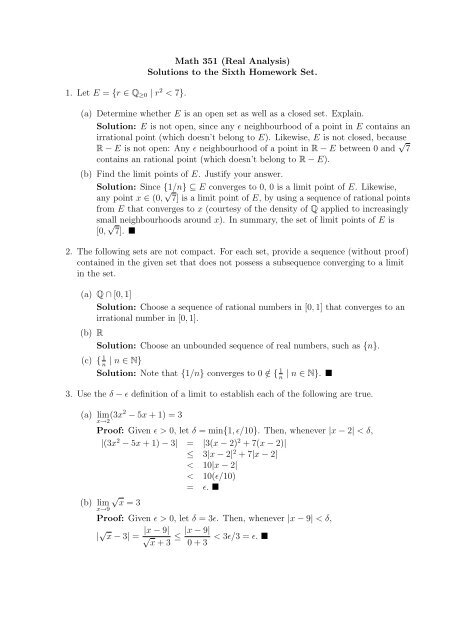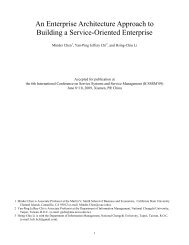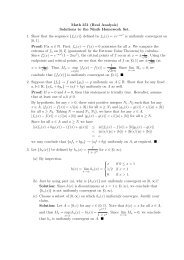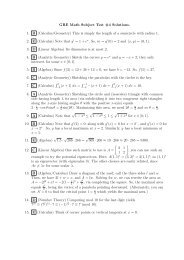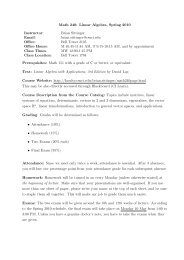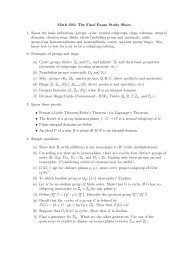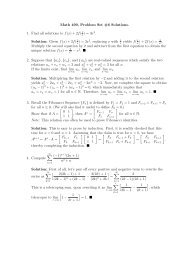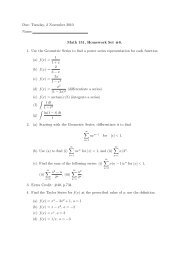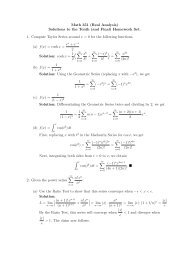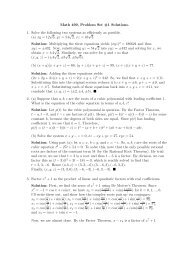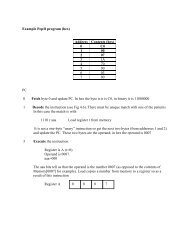Math 351 (Real Analysis) Solutions to the Sixth Homework Set. 1 ...
Math 351 (Real Analysis) Solutions to the Sixth Homework Set. 1 ...
Math 351 (Real Analysis) Solutions to the Sixth Homework Set. 1 ...
You also want an ePaper? Increase the reach of your titles
YUMPU automatically turns print PDFs into web optimized ePapers that Google loves.
1. Let E = {r ∈ Q ≥0 | r 2 < 7}.<br />
<strong>Math</strong> <strong>351</strong> (<strong>Real</strong> <strong>Analysis</strong>)<br />
<strong>Solutions</strong> <strong>to</strong> <strong>the</strong> <strong>Sixth</strong> <strong>Homework</strong> <strong>Set</strong>.<br />
(a) Determine whe<strong>the</strong>r E is an open set as well as a closed set. Explain.<br />
Solution: E is not open, since any ɛ neighbourhood of a point in E contains an<br />
irrational point (which doesn’t belong <strong>to</strong> E). Likewise, E is not closed, because<br />
R − E is not open: Any ɛ neighbourhood of a point in R − E between 0 and √ 7<br />
contains an rational point (which doesn’t belong <strong>to</strong> R − E).<br />
(b) Find <strong>the</strong> limit points of E. Justify your answer.<br />
Solution: Since {1/n} ⊆ E converges <strong>to</strong> 0, 0 is a limit point of E. Likewise,<br />
any point x ∈ (0, √ 7] is a limit point of E, by using a sequence of rational points<br />
from E that converges <strong>to</strong> x (courtesy of <strong>the</strong> density of Q applied <strong>to</strong> increasingly<br />
small neighbourhoods around x). In summary, <strong>the</strong> set of limit points of E is<br />
[0, √ 7]. <br />
2. The following sets are not compact. For each set, provide a sequence (without proof)<br />
contained in <strong>the</strong> given set that does not possess a subsequence converging <strong>to</strong> a limit<br />
in <strong>the</strong> set.<br />
(a) Q ∩ [0, 1]<br />
Solution: Choose a sequence of rational numbers in [0, 1] that converges <strong>to</strong> an<br />
irrational number in [0, 1].<br />
(b) R<br />
Solution: Choose an unbounded sequence of real numbers, such as {n}.<br />
(c) { 1 n | n ∈ N}<br />
Solution: Note that {1/n} converges <strong>to</strong> 0 /∈ { 1 n | n ∈ N}. <br />
3. Use <strong>the</strong> δ − ɛ definition of a limit <strong>to</strong> establish each of <strong>the</strong> following are true.<br />
(a) lim(3x − 5x + 1) = 3<br />
x→2<br />
Proof: Given ɛ > 0, let δ = min{1, ɛ/10}. Then, whenever |x − 2| < δ,<br />
|(3x 2 − 5x + 1) − 3| = |3(x − 2) 2 + 7(x − 2)|<br />
≤ 3|x − 2| 2 + 7|x − 2|<br />
< 10|x − 2|<br />
< 10(ɛ/10)<br />
= ɛ. <br />
√<br />
(b) lim x = 3<br />
x→9<br />
Proof: Given ɛ > 0, let δ = 3ɛ. Then, whenever |x − 9| < δ,<br />
| √ x − 3| =<br />
|x − 9|<br />
√ x + 3<br />
≤<br />
|x − 9|<br />
0 + 3<br />
< 3ɛ/3 = ɛ.
4. Give δ − ɛ definitions for <strong>the</strong> one-sided limits lim f(x) = L and lim f(x) = M.<br />
x→c− x→c +<br />
Solution: We say that lim f(x) = L if given any ɛ > 0, <strong>the</strong>re exists δ > 0 such that<br />
x→c− whenever c − δ < x, |f(x) − L| < ɛ.<br />
Likewise, lim f(x) = M if given any ɛ > 0, <strong>the</strong>re exists δ > 0 such that whenever<br />
x→c +<br />
x < c + δ, |f(x) − M| < ɛ. <br />
5. Let g : A → R and assume that f is a bounded function on A ⊆ R (i.e., <strong>the</strong>re exists<br />
M > 0 satisfying |f(x)| ≤ M for all x ∈ A). Show that if lim g(x) = 0, <strong>the</strong>n<br />
x→c<br />
lim g(x)f(x) = 0 as well.<br />
x→c<br />
Solution: By hypo<strong>the</strong>sis on f, <strong>the</strong>re exists M > 0 satisfying |f(x)| ≤ M for all<br />
x ∈ A. Moreover, given ɛ > 0, <strong>the</strong>re exists δ > 0 such that |x − c| < δ implies<br />
|g(x) − 0| < ɛ/M.<br />
Thus, |x − c| < δ implies that |g(x)f(x) − 0| < (ɛ/M)M = ɛ, as required.


